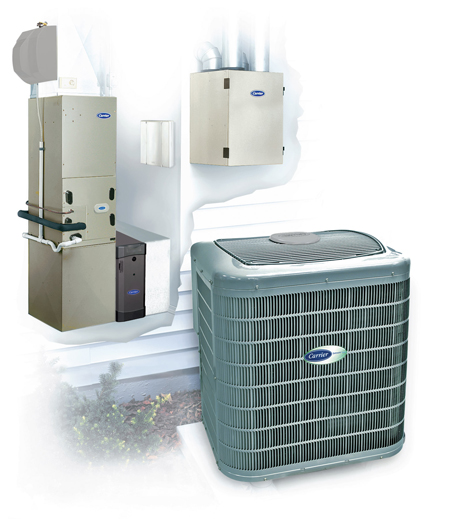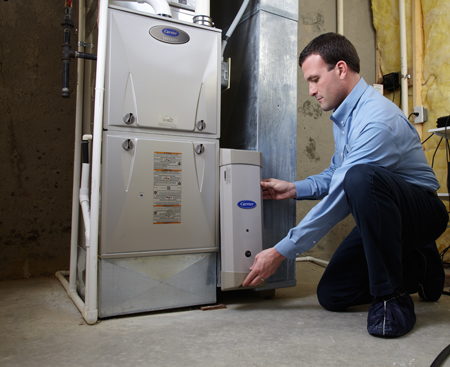Heating, Ventilation, and Air Conditioning (HVAC) Systems 101
Everyone knows of this one device that keeps us warm during the winter and cools during the summer. The Heating, Ventilation, and Air Conditioning (HVAC) system is to be thanked for this comfort. This system has revolutionized the way we live and made it more comfortable.
In addition, HVAC units have the added benefit of purifying the air inside our homes by removing dust, pollen, and other harmful particles. Leading to a healthier living environment.
But, how does this marvel of engineering work, and what are they made of?
In this piece, we will examine the fundamental principles of HVAC units, examine their primary elements, and grasp how they operate as cohesive units to enhance our indoor living spaces.
HVAC History
In the past, people had to rely on primitive heating and cooling methods to stay comfortable in their homes and buildings. They used fireplaces to keep warm in the winter and fans to stay cool in the summer.
But these archaic methods can sometimes prove inefficient, unreliable, and sometimes even downright dangerous.
Technological Advances
The industrial revolution brought with it the need for efficient food preservation technology. It was to efficiently commercialize food products for exports as well as raise the standard of living of every household.
In 1834, a conditioning system that cooled the air using compressors and refrigerants was invented. Evolving into the first-ever commercialized ice-making machine in 1854, and for domestic use by 1913.
This invention revolutionized indoor comfort and allowed people to live and work in hot and humid climates.
Heating and cooling systems were combined into a single HVAC (Heating, Ventilation, and Air Conditioning) system around the middle of the 20th century.
As time passed, HVAC systems continued to evolve and improve. For example, programmable thermostats, air filters, and zoning systems were developed to improve efficiency and indoor air quality.
Modern HVAC systems are highly advanced today, with features like smart controls and energy-efficient technology that allow for customized temperature control and energy savings.
Main Components of HVAC Equipment
HVAC (heating, ventilation, and air conditioning) systems control a building's temperature, humidity, and air quality. The system uses heating and cooling equipment, ductwork, a thermostat, an air filter, vents and registers, and optional humidifiers or dehumidifiers.
The efficient and successful operation of the HVAC system is dependent on each component. Therefore, all parts must work together seamlessly for an HVAC system to work correctly.
One component acting improperly can affect the entire system, resulting in poor performance, greater energy costs, and even health risks.
HVAC Equipment Components
- Heating and cooling equipment
Heating and cooling equipment generate hot or cold air in an HVAC system. Therefore, it is a critical component of an HVAC system. It is responsible for maintaining a comfortable, safe, and healthy indoor environment. Heating and cooling equipment are the main components of these appliances: - Furnace
A furnace is a heating device that burns fuel (natural gas or propane) to generate heat. The heat is then distributed through the building via ductwork. - Air conditioner
An air conditioner uses electricity to cool and dehumidify the air. It removes heat from the air and transfers it outside, leaving behind cool air that is then distributed through the building via the ductwork.
This component also allows us to regulate the temperature and humidity levels to ensure the space is neither too hot nor too cold. In addition, modern heating and cooling equipment is designed to be energy efficient. This means they use less energy to heat or cool the air, leading to lower energy bills and a reduced carbon footprint. - Installation
- Operation
- Reparation
- Maintenance
- Ductwork
The HVAC systems that deliver conditioned air across a building or residence must have ducts. Usually, they're formed of sheet metal, fiberglass, or some other substance. They are designed to be as airtight as possible to prevent leaks and energy loss.
The primary function of ducts is to transport air from the heating or cooling system to the various rooms or areas of the building. The air is forced through the ducts by a blower or fan in the HVAC system, and it is distributed to vents or registers in each room.
Ducts also serve an essential role in maintaining indoor air quality. The air that passes through the ducts is filtered to remove dust, pollen, other allergens, pollutants, and contaminants. This helps to ensure that the air in the building is clean and healthy to breathe.
Ducts must be installed and maintained correctly to ensure HVAC efficiency. Leaky ducts can also allow contaminants to enter, reducing indoor air quality and risking occupants' health. Faulty ducts also:- Waste energy
- Increase costs
- And reduce efficiency
- Thermostat
A thermostat is a device that controls the temperature of an HVAC system by sensing the temperature of the surrounding environment and adjusting the heating or cooling accordingly.
The primary function of a thermostat is to maintain a comfortable temperature inside a building or home. It does this by turning on the heating or cooling system when the temperature falls below or rises above a certain set point.
A properly functioning thermostat is essential for maintaining energy efficiency and reducing costs. It allows users to program and adjust the temperature to their desired level, which helps to prevent energy waste and reduce heating and cooling bills.
A thermostat is a device that controls the temperature of an HVAC system and maintains a comfortable indoor environment. It is essential for maintaining energy efficiency and reducing energy costs. - Air filter
An air filter is a device that removes airborne particles such as dust, pollen, and other allergens from the air passing through an HVAC system.
The primary function of an air filter is to improve indoor air quality by removing harmful pollutants from the air. This helps to prevent respiratory problems, allergies, and other health issues associated with poor air quality.
A properly functioning air filter is essential for maintaining HVAC efficiency and reducing energy costs. In addition, it prevents dust and other debris from accumulating on the heating and cooling equipment, which can reduce its efficiency and increase energy consumption. - Vents and registers
Vents and registers are openings in a building or home's walls, ceilings, or floors that allow conditioned air to flow in and out of rooms. They are essential for distributing conditioned air and maintaining HVAC efficiency.
The primary function of vents and registers is to distribute conditioned air throughout the building or home, providing a comfortable indoor environment.
Properly installed vents and registers are essential for maintaining HVAC efficiency and ensuring the even distribution of conditioned air. In addition, they help to prevent hot and cold spots in the building, which can reduce the effectiveness of the HVAC system and increase energy costs. - Humidifier/dehumidifier (optional)
Humidifiers and dehumidifiers are optional components of an HVAC system that adjust indoor air's humidity levels. The primary function of a humidifier is to add moisture to the air, which can help to prevent dry skin, nosebleeds, and other respiratory problems associated with low humidity.
Properly installed humidifiers and dehumidifiers are essential for maintaining indoor air quality and creating a comfortable indoor environment. They can also help to reduce energy costs by allowing occupants to adjust the temperature settings while maintaining a comfortable humidity level.
HVAC systems with proper heating and cooling equipment can help improve indoor air quality by circulating fresh air and filtering pollutants and allergens. To guarantee the machinery functions securely and effectively, it is essential to have proper:

Process of How HVAC Systems Function
HVAC equipment is designed to control and maintain the indoor climate of residential, industrial, and commercial buildings. The purpose of HVAC systems is to ensure the comfort and safety of occupants by regulating the:
- temperature
- humidity
- air quality
- air circulation
HVAC systems work by drawing in fresh air from outside, heating or cooling it as needed, and distributing it throughout the building via ductwork. This helps maintain a consistent temperature and humidity level, removes stale air, and circulates fresh air.
In addition to maintaining indoor comfort, HVAC systems can help improve indoor air quality by filtering pollutants and allergens. Therefore, HVAC systems are essential for creating a comfortable, healthy, and safe indoor environment for occupants, regardless of the outdoor weather conditions.
The Basic Process of Heating and Cooling Air in HVAC Equipment
HVAC systems control the temperature, humidity, and air quality, ensuring that occupants are comfortable and the indoor environment is safe and healthy.
The process of how HVAC works can be broken down into several key steps.
- Air Intake
The HVAC system takes fresh air from outside the building through vents and ducts. - Air Filtration
The air is then passed through air filters that remove unnecessary elements like:- Dust
- Pollen
- And other airborne particles
- Heating or Cooling
Depending on the desired temperature and the season, the air is heated or cooled as needed. For example, the air is heated during winter by passing it over a furnace. In contrast, the air is cooled during summer by passing it over an air conditioning unit. - Air Distribution
Once the air has been heated or cooled, it is distributed throughout the building via ductwork and vents. - Air Circulation
HVAC systems also circulate the air within a building, ensuring the temperature and humidity are consistent throughout the space. - Humidity Control
HVAC systems also control the humidity levels within a building. During hot and humid weather, the system removes moisture to reduce humidity. In contrast, during dry and cold weather, the system adds moisture to the atmosphere to increase humidity. - Thermostat Control
HVAC systems are controlled by a thermostat, which allows occupants to adjust the temperature and humidity levels to their desired comfort level.

Maintenance of the HVAC System
Proper maintenance of HVAC equipment is essential for ensuring its efficient and safe operation, prolonging its lifespan, and preventing breakdowns. Here are some general steps you can follow to maintain your HVAC equipment:
- Set up a regular maintenance schedule with a licensed HVAC technician. The frequency of maintenance will depend on the type of equipment and its usage.
- Replace air filters regularly, typically every 1-3 months, depending on usage. Dirty filters can reduce the system's efficiency and cause damage to its components.
- Clean the condenser and evaporator coils. Dirt and debris can accumulate on these coils, reducing their efficiency and causing system malfunctions. Have a professional technician clean the coils regularly.
- Check refrigerant levels, as low refrigerant levels can cause the system to operate inefficiently and damage its compressor. Have a technician check and refill refrigerant levels as needed.
- Regularly lubricate moving parts of the HVAC equipment to prevent friction and wear on the components.
- Have or hire a technician to inspect electrical components, such as motors and wiring, to ensure they operate safely and efficiently.
- Test the thermostat periodically to ensure it functions correctly and accurately controls the temperature.
- Clear debris from outdoor units. Debris such as leaves, dirt, and branches can accumulate around the outdoor unit. These unnecessary objects reduce the HVAC system's efficiency and can cause damage.
- Keep an eye on your HVAC system and track its performance. Report immediately to a licensed technician, if there are any unusual sounds or odors, reduced airflow, or other issues.
Conclusion
Nowadays, air conditioning systems are often taken for granted but it can’t be denied their importance to our comfort and well-being.
If you need any HVAC services, Custom Air Systems is the right place for you. As an A/C Expert team, we can help ensure your system is always operating at peak performance.
So, don't wait for your A/C to break down - contact experts today to keep your HVAC system running smoothly.


